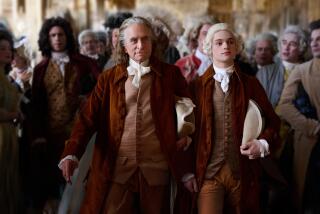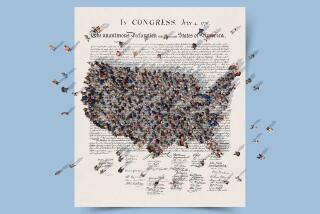Exploring U.S. History in Byways of Philadelphia
- Share via
“The summer was uncomfortably hot. Blinds offered some protection from the sun but the delegates were frequently uncomfortable in their close-fitting clothes and wigs. When the windows were shut to reduce the outside noise, the air became oppressive; when they were opened, flies buzzed in.”
Just another pleasant summer’s day in Philadelphia.
Summer in Philadelphia was probably the wellspring for the old joke: First prize is one week in Philadelphia; second prize is two weeks. Anyone who has ever suffered through a Philadelphia summer, when the humidity is so high the city’s ubiquitous pigeons seem to be swimming through the air, would probably agree.
But, hey, what’s a little humidity and heat when you will be able to participate this year is one of the nation’s grand events?
And maybe you’ll luck out; perhaps the weather will be kinder than what was described above by Robert Ferris and James Charleton in their book “The Signers of the Constitution.” After all, that was 200 years ago they were writing about; today not many of us wear wigs and most buildings have air conditioning--even the little 45 by 45 (foot) room in Independence Hall where the framers of the U.S. Constitution met for four months to hammer out one of the world’s most remarkable documents.
Perhaps the stifling Philadelphia summer of 1787 was what the 55 men from 12 states (Rhode Island refused to participate) needed to forge the Constitution. As James Madison said, time was the greatest tool of all. Even men with great differences hurried to get the work done quickly to escape home to the cooler climes of New Hampshire, Connecticut and the beautiful Blue Ridge Mountains.
‘Great Compromise’
At the beginning, diverse opinions threatened to scuttle the convention. The smaller states were jealous of the larger ones, the South distrusted the North, great property owners thought differently than merchants. The 55 men met and argued, then raged some more until --on July 16, 1787--they struck the “Great Compromise,” which set up equal representation for each state in the Senate, and representation by population in the House of Representatives. After the Compromise, it didn’t take long to complete the Constitution.
The Constitution has been amended only 26 times in the 200 years since it was written, 10 of those coming in 1791 in the Bill of Rights. That 55 men had the wisdom to write such a permanent document is, two centuries later, something “little short of a miracle,” as George Washington said when the task was completed and the final draft was signed by 39 delegates (three refused to sign; 13 had already gone home) on Sept. 17, 1787.
To honor the Constitution, and to lure tourists, Philadelphia is in the midst of a huge celebration to mark the document’s bicentennial. The centerpiece of the event is “Miracle at Philadelphia,” a multimedia show headquartered at the Second Bank of the United States, which is located just down the street from Independence Hall.
Displays and exhibits are scattered throughout the restored building, all bathed in soft light in the stately rooms of the old bank.
The exhibits first take you through the difficulties of early America, after the Revolution but before the Constitution. The country was in chaos in 1787. Each state printed its own money. States refused to pay taxes to a central government, so there were no funds to raise an army or navy. Americans were being hijacked in the Mediterranean and sold into slavery in North Africa. Outraged farmers were storming the courts to prevent foreclosure on their properties. And the national debt had risen to more than $100 million. Some things never change.
Through story boards, slide shows and documents (particularly James Madison’s detailed notes), visitors are led through the great issues. They can learn why slaves were counted as three-fifths of a person in determining states’ populations, and join the delegates as they debate the presidency.
For Trivia Buffs
Along the way you pick up some delicious trivia about the delegates: 9 were Princeton graduates, 2 were killed in duels, 1 was poisoned, 1 “disappeared in one day,” 8 had served at Valley Forge, 5 became members of the new Supreme Court, 12 became governors, 2 became President (Washington and Madison), 14 served as U.S. senators, 8 were congressmen, their ages ranged from 26 (Jonathan Dayton) to 82 (Ben Franklin).
At the end of the walk through this rich history, you are confronted by Franklin’s Sept. 17 admonishment to the delegates: “I consent, sir, to this Constitution because I expect no better and because I am not sure that it is not the best.” You can then sign a replica of the document, after which you’ll read another of Franklin’s musings: “Now you have a Republic, if you can keep it.”
Philadelphia has a fat list of events that will be staged throughout the year, including the first meeting of the U. S. Congress outside Washington since 1800. Both houses will meet July 16 at Judge Lewis Quadrangle, just across from the Liberty Bell, to mark the Constitution and the Great Compromise.
Special Events
There are events every month, culminating in Constitution Day (Sept. 17), which promises “the largest parade ever mounted” in the United States. There will be frequent special events, including performances by the city’s famous Mummers and Philadelphia Symphony, and--of course--the obligatory patriotic fireworks that accompany all events of this sort.
More information on individual events is available from the Philadelphia Convention and Visitors Bureau, 1515 Market St., Suite 2020, Philadelphia 19102; call toll-free (800) 523-2004. Ask for the “We the People Calendar of Events.”
Philadelphia is a city for history buffs. In addition to the Constitution displays, there is a splendid variety of tours available, including the excellent Audiowalk & Tour that will cost you $8 and help you to step back into the 18th Century as you walk the cobblestoned streets of our nation’s former capital.
The tour tape player can be picked up in the Norman Rockwell Museum, which is just across the way from Independence Square.
Among the sites that should be seen on any Philadelphia visit: Independence Hall, where you can enter the room in which both the Declaration of Independence and the Constitution were signed; the pavilion that contains the Liberty Bell; Congress Hall, where the government of the United States once sat; Franklin Court, which celebrates Ben Franklin and his extraordinary life; The Old City Tavern, where you can have a drink in the same room where Washington and Madison once drank; Elfreth’s Alley, a charming 270-year-old street aching with age, and Penn’s Landing, home to creaking sailing ships. Philadelphia has more than 100 museums, the country’s oldest zoo, America’s largest public park (Fairmount) and artwork scattered throughout.
Philadelphia has a wide range of hotels, from the elegant Four Seasons to the simple Motel 6. The closest hotel to Independence Square Historic District is the new Sheraton, which is only three blocks from the center of all the bicentennial action. The rooms are small, but nicely decorated and spotless, and the service is excellent. The hotel’s Americus restaurant is particularly pleasant, and its Spectacles nightclub is becoming a popular place to meet.
More to Read
Sign up for The Wild
We’ll help you find the best places to hike, bike and run, as well as the perfect silent spots for meditation and yoga.
You may occasionally receive promotional content from the Los Angeles Times.






